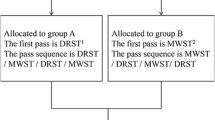Abstract
Purpose
Fine-needle aspiration cytology (FNAC) under ultrasound guidance is clinically useful, but there is a risk of spreading infection by generating droplets of contaminated fluids during the procedure. Risk assessment to better control infection remains to be established. The aim of this study was to estimate infection risks during FNAC by visualization of droplet production and deposition using a simulation model.
Methods
The simulation comprised a puncture needle, a device for holding the needle, and a fluid specimen containing fluorescent particles as a model. Simulating each step of FNAC (removal of the inner and outer cylinder and transferring the specimen onto a glass slide), the generation and deposition of droplets were visualized using a laser.
Results
After removal of the inner cylinder, an aerosol of droplets in the air surrounding the needle was observed. After removal of the outer cylinder, several large droplets precipitating onto the circumjacent surface were observed. From the beginning of transferring the specimen, a large amount of sizeable droplets first moving away and then precipitating was observed, followed by the production of a cluster of fine droplets drifting and spreading through the air.
Conclusions
Here, the generation of droplets at each step of FNAC, precipitation of large droplets onto the circumjacent surface, and drifting and spreading through the air of fine droplets was visualized. These results emphasize the need for precautions to prevent the transmission of infectious agents during FNAC.








Similar content being viewed by others
References
Kocjan G, Bourgain C, Fassina A, et al. The role of breast FNAC in diagnosis and clinical management: a survey of current practice. Cytopathology. 2008;19:271–8.
Tani E, Skoog L, Löwhagen T. Clinical utility of fine-needle aspiration cytology of the thyroid. Annu Rev Med. 1988;39:255–60.
Cozzolino I, Giudice V, Mignogna C, et al. Lymph node fine-needle cytology in the era of personalised medicine. Is there a role? Cytopathology. 2019;30:348–62.
Christiane M, Humphreys N, Humphreys H, et al. Infection prevention and control in ultrasound—best practice recommendations from the European Society of Radiology Ultrasound Working Group. Insights Imaging. 2017;8:523–35.
Siegel JD, Rhinehart E, Jackson M, et al. Guideline for isolation precautions: preventing transmission of infectious agents in healthcare settings. 2007. https://www.cdc.gov/infectioncontrol/guidelines/isolation/index.html. Last Update July 2019.
Marr LC, Tang JW, Van Mullekom J, et al. Mechanistic insights into the effect of humidity on airborne influenza virus survival, transmission and incidence. J R Soc Interfaces. 2019;16:150.
Anfinrud P, Stadnytskyi V, Bax CE, et al. Visualizing speech-generated oral fluid droplets with laser light scattering. N Engl J Med. 2020;382:2061–3.
Stadnytskyi V, Bax CE, Bax A, et al. The airborne lifetime of small speech droplets and their potential importance in SARS-CoV-2 transmission. Proc Natl Acad Sci USA. 2020;117:11875–7.
Gomi K, Nagahama M, Yoshida E, et al. Peroral endoscopy during the COVID-19 pandemic: efficacy of the acrylic box (Endo-Splash Protective (ESP) box) for preventing droplet transmission. JGH Open. 2020;4:1224–8.
Author information
Authors and Affiliations
Corresponding author
Ethics declarations
Conflict of interest
Kei Konno disclosed receipt of the following financial support for the research, authorship, and/or publication of this article: this study was supported by a grant-in-aid from the Foundation for Development of the Community. Harumi Koibuchi, Sayaka Yamamoto, Yamato Tada, Toru Kameda, and Nobuyuki Taniguchi declare that they have no conflicts of interest.
Ethical approval
This article does not contain any studies with human or animal subjects performed by any of the authors.
Additional information
Publisher's Note
Springer Nature remains neutral with regard to jurisdictional claims in published maps and institutional affiliations.
About this article
Cite this article
Konno, K., Koibuchi, H., Yamamoto, S. et al. Assessment of the risk of disease transmission during fine-needle aspiration cytology under ultrasound guidance by visualization of droplet and aerosol formation. J Med Ultrasonics 49, 471–480 (2022). https://doi.org/10.1007/s10396-022-01220-8
Received:
Accepted:
Published:
Issue Date:
DOI: https://doi.org/10.1007/s10396-022-01220-8




